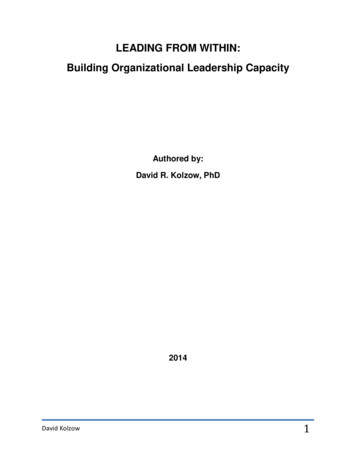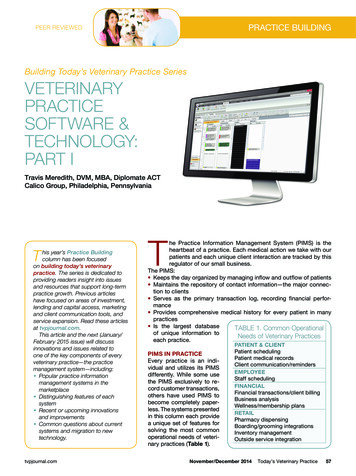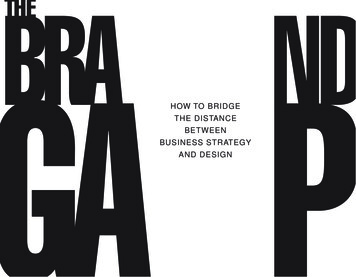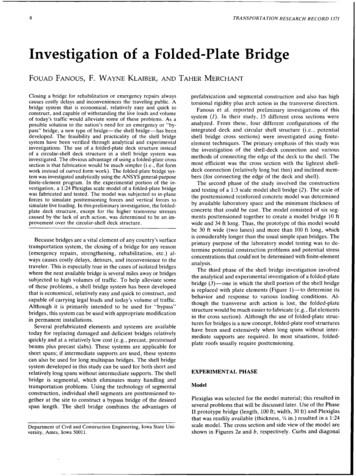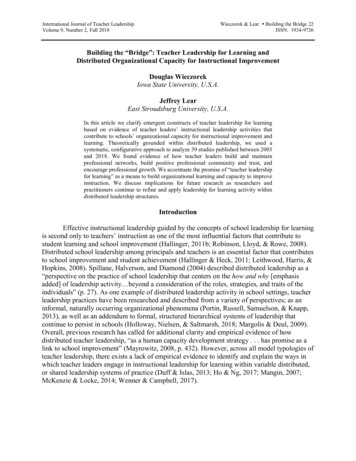
Transcription
International Journal of Teacher LeadershipVolume 9, Number 2, Fall 2018Wieczorek & Lear Building the Bridge 22ISSN: 1934-9726Building the “Bridge”: Teacher Leadership for Learning andDistributed Organizational Capacity for Instructional ImprovementDouglas WieczorekIowa State University, U.S.A.Jeffrey LearEast Stroudsburg University, U.S.A.In this article we clarify emergent constructs of teacher leadership for learningbased on evidence of teacher leaders’ instructional leadership activities thatcontribute to schools’ organizational capacity for instructional improvement andlearning. Theoretically grounded within distributed leadership, we used asystematic, configurative approach to analyze 39 studies published between 2003and 2018. We found evidence of how teacher leaders build and maintainprofessional networks, build positive professional community and trust, andencourage professional growth. We accentuate the promise of “teacher leadershipfor learning” as a means to build organizational learning and capacity to improveinstruction. We discuss implications for future research as researchers andpractitioners continue to refine and apply leadership for learning activity withindistributed leadership structures.IntroductionEffective instructional leadership guided by the concepts of school leadership for learningis second only to teachers’ instruction as one of the most influential factors that contribute tostudent learning and school improvement (Hallinger, 2011b; Robinson, Lloyd, & Rowe, 2008).Distributed school leadership among principals and teachers is an essential factor that contributesto school improvement and student achievement (Hallinger & Heck, 2011; Leithwood, Harris, &Hopkins, 2008). Spillane, Halverson, and Diamond (2004) described distributed leadership as a“perspective on the practice of school leadership that centers on the how and why [emphasisadded] of leadership activity beyond a consideration of the roles, strategies, and traits of theindividuals” (p. 27). As one example of distributed leadership activity in school settings, teacherleadership practices have been researched and described from a variety of perspectives; as aninformal, naturally occurring organizational phenomena (Portin, Russell, Samuelson, & Knapp,2013), as well as an addendum to formal, structured hierarchical systems of leadership thatcontinue to persist in schools (Holloway, Nielsen, & Saltmarsh, 2018; Margolis & Deul, 2009).Overall, previous research has called for additional clarity and empirical evidence of howdistributed teacher leadership, “as a human capacity development strategy . . . has promise as alink to school improvement” (Mayrowitz, 2008, p. 432). However, across all model typologies ofteacher leadership, there exists a lack of empirical evidence to identify and explain the ways inwhich teacher leaders engage in instructional leadership for learning within variable distributed,or shared leadership systems of practice (Duff & Islas, 2013; Ho & Ng, 2017; Mangin, 2007;McKenzie & Locke, 2014; Wenner & Campbell, 2017).
International Journal of Teacher LeadershipVolume 9, Number 2, Fall 2018Wieczorek & Lear Building the Bridge 23ISSN: 1934-9726Through the application of existing models of instructional leadership for learning, thereis an opportunity to leverage varied distributed leadership configurations and support teacherleaders’ efforts to build organizational learning capacity for instructional improvement (Bryant,Escalante, & Selva, 2017; Hallinger & Heck, 2011; Harris, 2003; King & Bouchard, 2011; Lai &Cheung, 2015; Lambert, 2003/2005; Louis & Lee, 2016; Spillane & Louis, 2002).Organizational learning capacity requires individual and group-level leadership for learningactivities that are “fundamentally focused on improving the core technology of schools, that is,instruction” (Spillane & Louis, 2002, p. 100). In this article, we propose that organizationalcapacity and learning can act as the conceptual framework “bridge” to align teacher leadershipfor learning practices within varying levels of distributed school leadership implementation thatare centrally focused on instructional leadership and improvement (Spillane & Louis, 2002, p.95). To advance this framework, we investigated if and how empirical research hasconceptualized instructional teacher leaders’ roles and activities to facilitate leadership forlearning within variable configurations of distributed practice.The purpose of this systematic, configurative literature review was to understand howteacher leaders can position their leadership for learning activity to improve instruction withindistributed school improvement systems. We focused on teacher leaders’ instructional leadershipfor learning practices that can potentially build organizational learning capacity as a means toimprove instruction and student learning. To guide our review, we addressed the followingresearch question: How have teacher leaders enacted leadership for learning and instructionalleadership activities in a distributed manner to develop or support organizational learningcapacity for instructional improvement? We assert that the field of teacher leadership researchhas only begun to engage in more specific empirical investigations of teacher leaders’ leadershipfor learning activities within multiple systems of hybridized distributed organizational leadershippractice. This lack of specific focus on teacher leaders’ leadership for learning practicespotentially limits the impact of teacher leadership as a theoretical construct and as anorganizational capacity lever to lead and influence instructional change. This structured literaturereview has the potential to impact future research and understanding of school leadershipcapacity building by identifying and analyzing gaps in our understanding of instructional teacherleadership that builds capacity for school-wide instructional leadership (Hallinger, Wang, &Chen, 2013; Lambert, 2002).We utilized distributed leadership as a theoretical perspective to identify and analyzeempirical evidence that contributes to our knowledge base regarding teacher leaders’ abilities toinfluence schools’ organizational learning capacity for instructional improvement. We situatedour analysis of teacher leadership research and practice across two inter-related areas: 1)teachers’ and teacher leaders’ roles within distributed leadership models of leadership practiceand 2) leadership for learning as a means to increase organizational capacity for instructionalchange.
International Journal of Teacher LeadershipVolume 9, Number 2, Fall 2018Wieczorek & Lear Building the Bridge 24ISSN: 1934-9726Distributed Leadership and Teacher Leaders’ RolesResearch on applied distributed leadership theory primarily examines the leadershipactivities of organizational actors, and not their formal positions of authority or jobresponsibilities (Daly et al., 2010; Ho & Ng, 2017; Spillane, 2006; Spillane, Halverson, &Diamond, 2001, 2004). Set apart from other conceptual ideas of leadership, distributedleadership models emphasize individuals’ inherent leadership potential, their contextualizedleadership activity, and their relationship exchanges as socially constructed leadership activityacross the collective organization (Spillane et al., 2001). Researchers have also identifiedevidence that principals play a critical, supportive role in facilitating and encouraging teacherleadership as a distributed phenomenon (Fairman & Mackenzie, 2015; Klar, 2012; Klar,Huggins, Hammonds, & Buskey, 2016; Margolis & Huggins, 2012; Wenner & Campbell, 2017;Pounder, 2006). In other cases, there exists deeply rooted hierarchical structures and cultureswhich reinforce the principal as the sole instructional leader, thereby minimizing teacher leaders’roles to potentially influence instructional growth (Klein et al., 2018; Nguyen & Hunter, 2018;Supovitz, 2018; Weiner & Woulfin, 2018).Scholars have acknowledged that distributed systems of teacher and leader practices areoften absorbed within existing hierarchical bureaucracies and contexts that predominantlyinclude the principal position as the school building leader (King & Bouchard, 2011). Distributedleadership systems can include multiple configurations of teacher, teacher leader, and principalinteractions and practices that can be hierarchical, flat, and reciprocal in nature and structure(Anderson, 2004; Hallinger, 2011; Hallinger, 2011b; Mulford & Silins, 2011). For example,King and Bouchard (2011) argued for a more relevant “hybrid” model that represents thecontexts and “elements of both the bureaucracy and the learning community” (p. 658). Theycontend that although “pure” distributed leadership systems have been shown to influence howschools build organizational learning capacity, capacity building requires a balance of both“administrative control and active broad participation” among all participants in the teaching andlearning community (p. 665). We applied a definition of distributed leadership that describeshow teacher leaders and principals interact and engage in leadership activity “among a networkof individuals . . . within a specific social and cultural context. . . [as a] collectively performedactivity system” (Ho & Ng, 2017, p. 225). Bureaucracy is a fundamental aspect of schooling, andwe assert that teacher leadership exists and grows within contextually dependent bureaucraticenvironments that persist in schools today. For many reasons, practitioners and researchers havegrappled with the definitions of a “teacher leader,” and as a result, this has generated conflictingdiscourse on the role and future of teacher leadership in schools.Teacher leadership definitions and models. The roles and definitions of teacherleadership have evolved since the original notions of the “lead teacher,” “teachers as leaders,”and “teacher leadership opportunities” (Crowther & Olsen, 1997; Smylie & Denny, 1990). Mostnotably, researchers have identified theoretical and practical discrepancies between distributedschool leadership theoretical constructs (Bolden, 2011; Harris et al., 2007; Mayrowitz, 2008;Mulford, 2008) and teacher leaders’ leadership activities for school improvement (Harris, 2005;Jacobs et al., 2016; Mujis & Harris, 2003; Wenner & Campbell, 2017; York-Barr & Duke,2004). These discrepancies may be due to the variety of definitions used over time and thevariability in teacher leadership models.
International Journal of Teacher LeadershipVolume 9, Number 2, Fall 2018Wieczorek & Lear Building the Bridge 25ISSN: 1934-9726Some models have focused on the participatory elements of teacher leadership practicewhich enhance teacher leaders’ roles to improve school culture and elevate teachers’professionalism (Fairman & MacKenzie, 2012). For example, in their study of 13 teachers andtwo paraprofessionals in Australia, Crowther and Olsen (1997) outlined a five-categoryframework of teacher leaders’ activities: articulates clear views of a better world; models trustand sincerity, confronts structural barriers, builds networks of support, and nurtures a culture ofsuccess, with 18 sub-characteristics and behaviors (p. 11). In another example, Wenner andCampbell’s (2017) prominent review of 54 published research articles on teacher leadershipfound five general themes that scholars have used to define teacher leadership: teacher leadersshould exercise influence within and beyond classroom walls, teacher leaders should supportprofessional learning in their schools, teacher leaders should be involved in decision making,teacher leaders should focus on student learning, and teacher leaders should work towards wholeschool and organizational change (p. 146). These models have described broad organizationalgoals which may improve professional practices and organizational culture, but are not centrallyfocused on instructional leadership activities.Moving closer to specific instructional improvement and capacity building concepts,other models of teacher leadership have explicitly stated teacher leadership domains andcompetencies that define effective teacher leadership practices and behaviors (Smylie & Eckert,2018). A diverse group of stakeholders created the Teacher Leader Model Standards (TLMS)brought together as the Teacher Leadership Exploratory Consortium (2011). The TLMS outlinedseven domains of practice which are supported by 37 identified functions of teacher leadershippractice. The TLMS domains include fostering collaborative culture to support educatordevelopment and student learning, accessing and using research to improve practice, promotingprofessional learning for continuous improvement, facilitating improvements in instruction andstudent learning, promoting the use of assessments for school and district improvement,improving outreach and collaboration with families and community, and advocating for studentlearning and the profession (TLMS, 2011). More recently, the Center for Teaching Quality(2014) published the Teacher Leadership Competencies (CTQ-TLC). Included in the CTQ-TLCmodel are four main competency areas: overarching, instructional leadership, policy leadership,and association leadership. Among these competencies, the model identifies 20 domains ofpractice that support teacher leadership development, reflection, and growth. Within these 20domains, several indicators are attributed to “instructional leadership” practice, includingcoaching/mentoring, collaborative relationships, and community. These distinct perspectives andmodels of teacher leadership demonstrates how teacher leadership definitions and expectationsare still evolving, but may not be centrally focused on classroom instruction improvement.In consideration of the variety of teacher leadership perspectives and definitions, we drewon York-Barr and Duke’s (2004) definition of teacher leadership as the process “by whichteachers, individually or collectively, influence their colleagues, principals, and other membersof school communities to improve teaching and learning practices with the aim of increasedstudent learning and achievement” (emphasis added, p. 287). This definition aligns with morerecent applications of leadership for learning, distributed leadership theory, and the importanceof organizational learning and capacity to influence organizational leadership among allstakeholders and instructional change as two primary goals for school improvement (Smylie &Eckert, 2018).
International Journal of Teacher LeadershipVolume 9, Number 2, Fall 2018Wieczorek & Lear Building the Bridge 26ISSN: 1934-9726Leadership for Learning and Organizational CapacityThe most recent models of integrated instructional leadership, or leadership for learning,stress the vital role of collaborative, shared leadership in schools’ efforts to improve instructionalpractices and increase organizational leadership capacity (Robinson et al., 2008; Marks & Printy,2003; Hallinger & Heck, 2010a/2010b). Although a lack of consensus exists regarding theparticular leadership for learning domains that are the most salient to school improvementprocesses (Leithwood & Sun, 2012), there are core instructional leadership activities widelyaccepted as germane to instructional improvement processes.While collaborative or shared leadership practices are not conceptual or theoreticalequivalents to distributed leadership, they contain essential elements of a distributed leadershipsystem, such as the collective leadership roles of all staff, a shared sense of purpose, contexts ofleadership, sharing of power, and collaborative culture (Marks & Printy, 2003; Hallinger,2003/2011). Instructional leaders should attend to core elements of instructional improvement,including setting mission, vision, and goals; managing curriculum and resources; supervising andevaluating teaching; monitoring student learning; and maintaining positive organizationalclimate (Hallinger, 2011). Leadership for learning emphasizes not only the role of the principalbut the collective leadership capacity of all individuals to affect school-wide instructionalimprovement (Hallinger & Heck, 2010b). Also, principal leadership provides essential support todevelop teacher leadership identities, practices, and processes (Fairman & Mackenzie, 2015;Wenner & Campbell, 2017; Pounder, 2006), which are essential for improved teaching andlearning outcomes.Leadership for learning and organizational capacity. Multiple definitions and modelsof leadership capacity exist (e.g. Cosner, 2009; Lambert, 2002; Lethwood & Mascall, 2008;Youngs, 2001; Youngs & King, 2002), however we focused our examination on organizationallearning capacity within distributed leadership systems that involve the school improvementinteractions of teachers, teacher leaders, and principals (King & Bouchard, 2011; Spillane &Louis, 2002). Individual and collective professional organizational growth is key to schoolimprovement processes by considering “the kinds of leadership that can be distributed . . . . tobuild internal capacity for development (Harris, 2004, p. 12-13). We drew on two mainconceptual frameworks which focus on instructional leadership capacity and student learning(King & Bouchard, 2011; Spillane & Louis, 2002)The first example, Spillane and Louis (2002) constructed a conceptual framework ofschool improvement that “anchors” instruction and student learning as the primary drivers oforganizational learning and capacity (Spillane & Louis, 2002, p. 83). Organizational learning is aprocess where members adopt “new knowledge, skills, and tools . . . as a collective . . . [and] areengaged in a common activity . . . as an ensemble” (Spillane & Louis, 2002, p. 95). Spillane andLouis’ work centrally positions student learning as the main purpose for building capacity toimprove teachers’ skills, classroom instruction, and professional community within distributedsystems of practice.
International Journal of Teacher LeadershipVolume 9, Number 2, Fall 2018Wieczorek & Lear Building the Bridge 27ISSN: 1934-9726Their first construct, instructional improvement, includes the interactions among severalinstructional processes, such as teachers’ knowledge, beliefs, and understanding of students’needs and student learning processes. For example, these include how teachers employ certainelements in their instruction: knowledge about learner characteristics; teachers’ assumptions andexpectations about teaching and learning; content knowledge; pedagogy; curriculum; contentspecific pedagogical knowledge; and application of learning theories and methods (Spillane &Louis, 2002).Their second construct, school improvement structures and processes, includes theinteractions within and across classrooms as a site of teacher learning and the levels and types ofengagement within teachers’ professional community. For example, these include how structuresand professional interactions facilitate: shared instructional vision; developing a culture of sharedbeliefs, trust, and collaboration; allocation of resources; supporting teacher growth; andfacilitating instructional supervision and mutual improvement among a professional community(Spillane & Louis, 2002).The second example, King and Bouchard (2011) included distributed leadership in theirmodel of school organizational learning capacity which subsequently influences school-wideinstructional quality and student achievement. Their model outlines the reciprocal interactionsamong several elements of principal, teacher, and teacher leader behavior within distributedforms of leadership to improve teaching and learning “in ways that advance the collective workin their schools . . . exercised in an organized, collective enterprise” (King & Bouchard, 2011, p.654-655). These elements include teachers’ knowledge, skills, and dispositions; professionalcommunity; technical resources; and program coherence. In their model, teachers’ growthrequires increasing their know
leadership practices have been researched and described from a variety of perspectives; as an informal, naturally occurring organizational phenomena (Portin, Russell, Samuelson, & Knapp, 2013), as well as an addendum to formal, structured hierarchical


